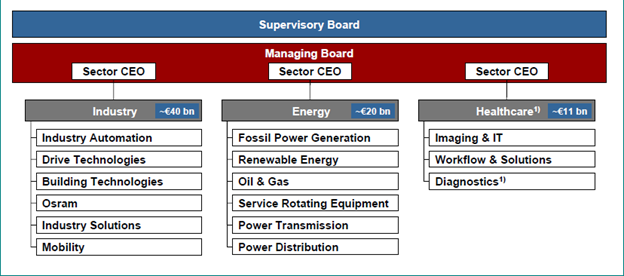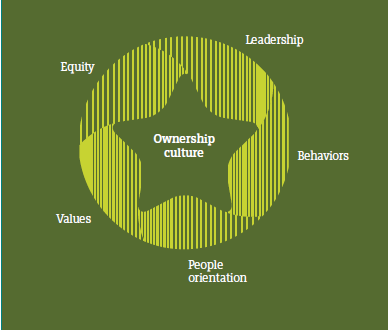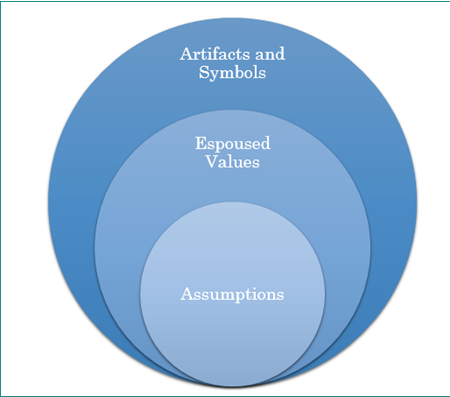Discuss about the Organizational Culture at Siemens.
Organizational behavior can be defined as the study of how individuals behave in a work set-up both individually and as a team (McShane, 2015). The term is coined so, as this study is a key contributor to understand how an organization works and how its productivity can be improved, since any organizations would need its people to work together as teams to achieve organizational goals. Organizational behavior helps in interpreting the values, beliefs and all such aspects of an organization by analyzing how individuals working for the organization perceive these beliefs and integrate them with their own values (Langdon, 2013). The same can also be used to explain the culture within an organization. The various concepts involved in organizational behavior is the behavior of the individual in isolated situation, behavior of individuals in work groups and the behavior of the organization itself (DuBrin, 2013). The below report is an analysis on understanding how workgroup, teams, power and politics which are all major concepts of organizational behavior effect the organizational culture at Siemens.
Siemens AG is a German based company with diversified branches of Industry, Energy, Healthcare and Infrastructure. Established in 1847, Siemens defines itself as a global powerhouse with great focus on automation and digitalization. The company employs 348,000 people in 200 countries and hence is one of the best examples to understand how a company this size can manage its employees efficiently.
The below image shows the corporate structure of Siemens Ag.

Figure 1: Organizational Structure of Siemens Ag; Source: https://www.siemens.com/press/pool/de/events/pressegespraech/press-briefing-silde.pdf
The above image shows a simpler version of the current corporate structure of Siemens. The Company has a supervisory board comprising of 20 members. This board oversees and advises the managing board discussing business planning, strategies and implementation. The Managing Board has 8 members along with the CEO of Siemens who take charge of the management of the entire organization. Also, since the company is significantly diversified, each sector has its own CEO called the sector CEO who report to one of the managing board members. In such a complex set up, it is highly important for individuals to work as teams and communicate and coordinate with each other to ensure that the division they work for can reach the goals set by the managing board.
For such a large setup a firm organizational culture is required to ensure that the company holds together as one and work for a common goal. The organization culture at Siemens is called Ownership Culture, where it is said that every individual should apply the level of performance and vigor as if it was their own company.
Siemens Structure

Figure 2: Culture at Siemens; Source: https://www.siemens.com/about/pool/strategy/siemens-strategy-overview-culture.pdf
The culture encompasses Leadership, Equality, Behaviors, Values and People Orientation as key factors of its culture. The culture is based on the company values and people oriented where each individual is responsible for the growth of the company and managers serving as role models (Thompson, 2013).
A detailed understanding of Siemens culture can be achieved with the help of the Edgar Schein organizational culture model which is also called as the Onion model. The model consists of three layers that depict the level of the depth to which the culture is embedded in the organization.

Figure 3: Schien’s Organizational Cultural model
1. Artifacts and Symbols: This aspect of the cultural model is more of a visual representation of the culture in the organization. One can see this in their logos, dress codes, taglines and so on. It is upfront visible to the world to understand the culture in an organization. Siemens artifacts shows its culture in several artifacts. For instance, the tag line of the company is “Ingenuity in Life”. Siemens believes that innovation is one the most important factors for the continuous growth of the organization and the same is spread through their tagline. The constant work in the fields of manifesting, intelligent infrastructure, Sustainable energy and digitalization are all proofs for the company’s inventive culture. One place where the company’s culture of transparency can be seen is through there official website which has details of all the products, services and events of the company.
2. Espoused Values: These are the conscious goals and strategies of the company. Even the best strategies fail when it is not supported by a string culture. Siemens consciously imbibes the high performance goals into each of the employee’s objectives. The same is done through the ownership culture of the company where people orientation is high and each employee is expected to work as if the company was theirs.
3. Assumptions: These are difficult to recognize as they are self-evident and unconscious behavioral aspects. At Siemens a sense of entrepreneur culture is maintained to ensure ingenuity and the values of responsibility, sustainability and leadership are the assumptions that are present in Siemens.
Every organization has several sets of work groups that work towards the common goals of the organization. At collective group of people working for a single project but performing several independent functions can be termed as a work group (Bittner, 2013). These groups often have a common purpose and contribute individually to the achievement of these goals. The simplest visible work group in any organization is the whole organization itself. Every employee of an organization is a part of a group that is focusing on achieving the organizational goals. A simple situation such as the sale of a product involves people from several segments such as marketing, sales, finance and customer service. However, the functioning of each of these departments is not inter-related.
Siemens Culture
Work Groups have a significant effect on the organizational culture and vice versa. Since work groups involve individual persons, the way of communication, behaviors and individual values effect the performance and productivity of organization (Nielsen, 2013). A work group culture increase the sense of respect, appreciation and communication is the company
Teams are made of members who work for a goal through collective performance, accountable for their work and the work of the team and have complementary skills to complete a set task. There are several models that explain how a team functions. The kind of teams formed in an organization sheds light on how the organization culture is developed (Alvesson, 2015).
Teams comprise of employees that work together for a common goal. For example the Employee Grievance team of an organization works solely to understand the various issues of the employees of the company and resolve the same. The organization culture which has multiple teams working in it is collaborative in nature as communication plays a vital role in passing information (Erkutlu, 2012). Taking the example of Siemens, the company has several teams led by a team leader that work for each individual division. Each division has managers who report to the division CEO. Each of the team is given a set task to be completed within a set period of time with a team leader who is thoroughly involved in planning and implementing of the solution. The team leaders need to motivate and drive the team to achieve its set goals in the most efficient way possible. These kind of teams need a leader who can be looked upon as a role model. The leader has to understand the skills of each of the team member and be able to assign appropriate tasks to each of the individual. At the same time, employees working in a team would have their individual aspirations and the leader has to make sure that they are being valued. Such a set up when seen in several teams develop a culture that is motivating, encourages leadership and is people oriented (Guinalíu, 2016).
In a company that has a hierarchal structure power is not evenly distributed across all its employees. A CEO and a new joiner of the company will not have the same power in the company. The concept of power in an organization is introduced to ensure that decisions are made based upon the experience and responsibility a person has in the organization. This ensures that the organization is kept in order (Lumby, 2012).
Work Groups and Teams
In Siemens, the managing board has significant powers as they are responsible for the entire company. Though the supervisory board sits above them, they only supervise and advice the managing team and do not actually make decisions. The Division CEOs have a complete controls of their division. However, decisions that would affect their division as whole or effect another division cannot be carried out by the CEOs.
Power is a crucial factor in understanding the kind of organizational culture that develops. A high use of power and strict lines between two levels of power usually lead to an Autocratic culture where a major share is lead with the manager (De, 2015). The employees are to do what is told and questioning the judgment of a manager can be considered as a mistake. These kind of cultures are not highly appreciated and are often de motivating leading to a decrease in performance of the organization. This is one of the major reasons for organizations to a horizontal corporate structure ensuring a friendly corporate culture (Alvesson, 2012).
Politics can be defined as the act of getting things done in one’s favor either by the use of power or power relations. This is usually termed as a negative aspect while situations where positive outcomes especially those that are beneficial to the organization may arise. When the need for politics is not for the growth of the managers themselves but to complete a crucial task or acquire an important asset, politics can be positive. It is the intentions behind the person that matter. However, in several cases politics leads to a negative organizational culture (Geppert, 2013).
Politics in an organization may also lead to goal incompatibility, demotivation, differentiation, anger and frustration amongst victims of a political situation occur. When a manager misuses the power to grow in the organization or favor an employee over the other, a demoralized and negative organizational culture arises. Politics are often a part of the organizational life as each individuals has different goals. However, the urge for power and developing power bases would not only reduce the productivity of the company but also changes the attitude of people in the company (Kacmar, 2013).
In case of Siemens, the company has strict policies to avoid negative effects of politics and through its organizational culture boosts an environment of collaboration and ownership, rather than submissive attitude. The power is distributed according to the position rather than the person and the employee’s for each of these position are elected based on their performance rather than their power circle.
Employee management is an important factor for an organization to run successfully and hence there is immense emphasis on developing a culture that is employee oriented. Job satisfaction, learning opportunities, work-life balance, motivation and the need to be heard are some of the factors that are required to ensure a productive employee (Bell, 2014). A company that provides all of the above and takes great care of how its employees are being treated eventually grows into a successful organization. Siemens places great importance to employee management. The below figure shows the extent of employee involvement at Siemens.

Figure 4: Employee involvement in Siemens; Source: https://www.siemens.com/annual/12/en/company-report/employees-and-management-culture/
The first step in their agenda to ensure motivation and job satisfaction is the development of their performance management continuous model. Siemens has a bi-annual performance cycle which involves the employees and managers to develop a list of objectives for the employee to complete within a time period. The manager then helps the employee complete these objective by guiding them throughout the period and then accessing the employee performance. This ensures that the employee gets a choice to decide their goals and has a constant guidance system to complete the same (Shields, 2015).
Also, to ensure learning outcomes, Siemens invests in tremendously for the professional development of its employee. Work-life balance is given an equal importance and hence the concept of flexible work timings have been introduced by Siemens. The company also has several programs such as the Global Leadership Organization of Woman (GLOW) that embraces woman leadership, Siemens diversity ambassadors that take care of diversity issues in the company. From 2007 to 2012 alone the company has implemented 500,000 employee suggestions in to practice.
Conclusion
In an MNC like Siemens, the organizational culture is developed hand-in-and with the team culture, distribution of power and politics in the organization. To ensure a positive, motivating and productive culture is it important to develop employment policies that are people oriented and curb the negative effects of power and politics. A clear definition of the job roles and an understanding between the manager and the employees ensure a growing environment. Emphasizing on the employee needs and aligning them with the organizational vision develops an employee oriented organizational culture that is highly productive and efficient.
References
Alvesson, M. and Sveningsson, S., 2015. Changing organizational culture: Cultural change work in progress. Routledge.
Alvesson, M., 2012. Understanding organizational culture. Sage.
Bell, R.L., 2014. Managerial communication. Business Expert Press.
Bittner, E.A.C. and Leimeister, J.M., 2014. Creating shared understanding in heterogeneous work groups: Why it matters and how to achieve it. Journal of Management Information Systems, 31(1), pp.111-144.
De Hoogh, A.H., Greer, L.L. and Den Hartog, D.N., 2015. Diabolical dictators or capable commanders? An investigation of the differential effects of autocratic leadership on team performance. The Leadership Quarterly, 26(5), pp.687-701.
DuBrin, A.J., 2013. Fundamentals of organizational behavior: An applied perspective. Elsevier.
Erkutlu, H., 2012. The impact of organizational culture on the relationship between shared leadership and team proactivity. Team Performance Management: An International Journal, 18(1/2), pp.102-119.
Geppert, M., Becker-Ritterspach, F. and Mudambi, R., 2013. New organizational perspectives on the study of politics and power in the multinational company. Organization Studies, 34(5-6), pp.867-869.
Guinalíu, M. and Jordán, P., 2016. Building trust in the leader of virtual work teams. Revista Española de Investigación en Marketing ESIC.
Kacmar, K.M., Andrews, M.C., Harris, K.J. and Tepper, B.J., 2013. Ethical leadership and subordinate outcomes: The mediating role of organizational politics and the moderating role of political skill. Journal of Business Ethics, 115(1), pp.33-44.
Langton, N., Robbins, S.P. and Judge, T.A., 2013. Fundamentals of organizational behaviour. Pearson Education Canada.
Lumby, J., 2012. Leading Organizational Culture Issues of Power and Equity. Educational Management Administration & Leadership, 40(5), pp.576-591.
McShane, S.L. and Von Glinow, M.A., 2015. Organizational Behavior 7/e.
Nielsen, M.B., 2013. Bullying in work groups: The impact of leadership. Scandinavian journal of psychology, 54(2), pp.127-136.
Shields, J., Brown, M., Kaine, S., Dolle-Samuel, C., North-Samardzic, A., McLean, P., Johns, R., Robinson, J., O'Leary, P. and Plimmer, G., 2015. Managing Employee Performance & Reward: Concepts, Practices, Strategies. Cambridge University Press.
Thompson, P.B., Shanley, M. and McWilliams, A., 2013. Ownership culture and strategic adaptability. Journal of Business Strategies, 30(2), p.145.
To export a reference to this article please select a referencing stye below:
My Assignment Help. (2017). Organizational Culture At Siemens. Retrieved from https://myassignmenthelp.com/free-samples/organizational-culture-at-siemens.
"Organizational Culture At Siemens." My Assignment Help, 2017, https://myassignmenthelp.com/free-samples/organizational-culture-at-siemens.
My Assignment Help (2017) Organizational Culture At Siemens [Online]. Available from: https://myassignmenthelp.com/free-samples/organizational-culture-at-siemens
[Accessed 20 May 2025].
My Assignment Help. 'Organizational Culture At Siemens' (My Assignment Help, 2017) <https://myassignmenthelp.com/free-samples/organizational-culture-at-siemens> accessed 20 May 2025.
My Assignment Help. Organizational Culture At Siemens [Internet]. My Assignment Help. 2017 [cited 20 May 2025]. Available from: https://myassignmenthelp.com/free-samples/organizational-culture-at-siemens.
